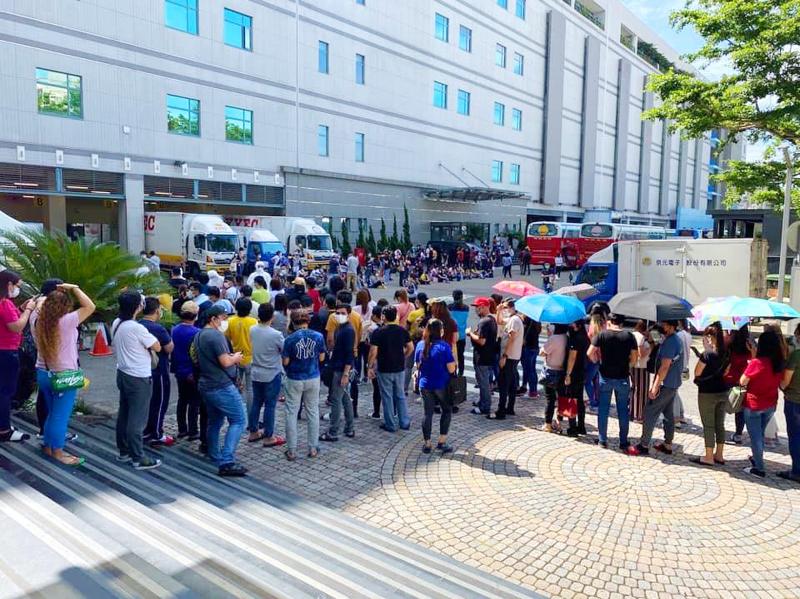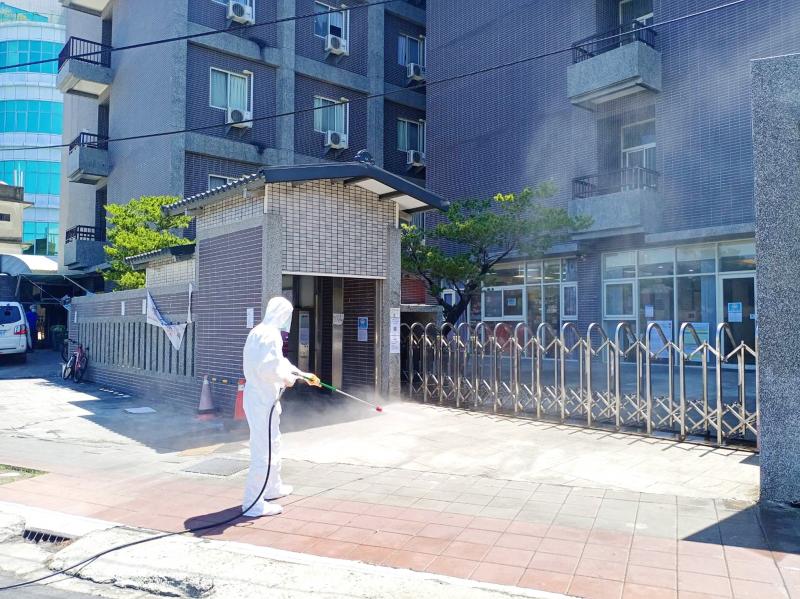By the end of last year, over 150,000 migrant workers in Singapore had been infected with COVID-19, roughly 47 percent of its migrant worker population. Their lives, already under harsh control in situations worse than in Taiwan, came under even stricter rule. Whole dorms were quarantined and even healthy workers were allowed out only infrequently, to shop in designated shops and, of course, to work. To its credit, the government did force employers to pay workers, and gave them medical care and support.
Yet, in the end, the Singapore worker outbreak underwrote even tighter controls on the migrant worker population. Many of us have been fearing that outcome here in Taiwan.
Last week there were two outbreaks among migrant workers at different companies. These cases signal that we could be on the cusp of a Singapore-like disaster, with workers overwhelmed by the virus, threatening everything from human lives to Taiwan’s economy and place in the global supply chain.

Photo courtesy of a member of the public
Government officials have repeatedly averred that keeping the economy ticking along is an important priority in getting the nation through this crisis.
Prove it: vaccinate migrant workers. Now.
It is long past time to move migrant workers to the top of the priority list, after health care workers and other at-risk populations, for vaccination. And it should be free — use the 1.2 million doses of vaccine that Japan is sending us. There is hardly a more threatened population in Taiwan.

Photo courtesy of the Miaoli County Environmental Protection Bureau
INVISIBLE, BUT PRESENT
Migrant workers in many ways are a population known to exist, yet somehow invisible. Ghettoed in their own communities surrounding dorm areas near industrial districts, we hardly see them. They have their own eateries and shops, where they buy their own products from their home countries, right? Their own churches and community centers, no? They are isolated from us, right?
Nope.
Last week the news broke of a cluster of cases at the King Yuan Electronics Co’s dorm in Miaoli County’s Jhunan Township (竹南). That cluster is an excellent example of how the migrant worker population is not a population that is isolated from the mainstream, but part of it.
In Zhunan there is a small shopping mall that is a magnet for the towns around it. King Yuan workers go there to enjoy themselves, and to a large market where they go to buy food. They go out to the same restaurants, stay at the same hotels and shop in the same popular chain stores as the locals.
Who hasn’t seen the Sunday trains filled with workers going traveling across Taiwan to meet friends and relatives? Same as the locals.
These regular contacts in migrant worker spaces like ASEAN Plaza in Taichung or the Taipei Main Station bring together not only people from different dorms, but also mingle caregivers and factory workers with restaurant personnel and their Taiwanese suppliers. The migrant worker communities are thus heavily networked and can easily spread the virus from one place in Taiwan to another.
Many migrant workers have illegal second jobs, often cleaning or serving local businesses and homes. There is also an enormous population of runaways, working in factories, on farms in the mountains and in brothels, who naturally stay in touch with their own communities and who also have regular contact with the local population.
MIGRANT-TAIWANESE INTERACTION
Understanding how interconnected the migrant worker population is, after the cluster was revealed, migrant workers in other companies were immediately given forms asking if they had been in contact with workers at King Yuan. Other companies have asked their workers to remain in their dorms, offering free food and other perks in compensation.
Romantic relationships are common. There is a whole subculture of locals married to former migrant workers. Naturally foreign spouses maintain contact with their former worker communities. Many of them operate little shops and restaurants that cater to that population, switching back and forth between the two worlds of the mainstream population and the migrant population.
They also interact in other ways. Around areas where workers congregate there are cheap rooms to let, sometimes just for a night, often for long-term. For example, a friend of mine rents a room with her boyfriend (who works at another firm in the next city) next to the train station, one stop from her dorm. Every morning she takes the train back to her dorm, buys breakfast on the way and then takes the bus to the factory, interacting with many others along the way.
Their relationship is thus an intimate link between two otherwise separated dorm populations and the local area. Such arrangements are common.
MIGRANT-EXPAT INTERACTION
Like myself, many expats in Taiwan are dating migrant workers. Our two heavily networked populations thus interact, overlapping with everyone we come into contact with.
So what? This just means that migrant workers are like all other humans in Taiwan, then, right?
Migrant workers have two crucial differences from the rest of us. The first is that when the rest of us go home at night, we go back to an apartment that we share with a few other people, often with rooms to ourselves. An outbreak in our home can be contained.
By contrast, migrant workers return to dorms that they share with hundreds of others, sleeping six or eight to a room. Spaces in dorms, like kitchens and leisure areas, are shared spaces. One infected person can easily infect scores.
MIGRANT WORKERS CRITICAL TO ECONOM
The other crucial difference is that few of us are important to the economy either individually or collectively. But it would be a severe problem for global supply chains if several key tech firms in Taiwan found their migrant worker populations unable to work because of COVID-19.
King Yuan is not a household name like Taiwan Semiconductor Manufacturing Co (台積電) or Asus, but it is globally prominent in its testing and assembly markets.
Another issue should be pondered. Beginning last year, as the government rolled out surveillance techniques for COVID-19 cases, civil society organizations in Taiwan began protesting that these were anti-democratic. Migrant workers are already a heavily restricted, surveilled and tracked population. In many dorms, for example, workers must fill out a form when they go out overnight, and dorms are electronically gated. Some workers are not allowed out overnight at all.
Guess what: migrant worker surveillance is population surveillance. It is a truism of history that surveillance techniques developed to monitor marginal populations will inevitably leak into use against the mainstream population, which was fine with such treatment when it was applied to the Other. Racism, after all, was invented so the authorities could control both sets of populations, the marginal and the mainstream.
Already we must swipe a QR code for the places we visit — even taxis and betel nut stands have them now. What will happen to this enormous pool of data the government has acquired on our social and consumption habits? What further potential is there for abusive control in anti-pandemic measures?
My guess is the government will promise not to do anything anti-democratic with that data, as governments always do, and then use these techniques and the data they gather in ways the population would not approve of, if it knew. The temptation is too great even for the most democratic of governments.
Vaccinating the migrant workers would address all of these issues. It would protect the economy, save human lives and reduce the trend toward authoritarianism inherent in surveillance by making it less necessary.
Let’s do it. This week.
Notes from Central Taiwan is a column written by long-term resident Michael Turton, who provides incisive commentary informed by three decades of living in and writing about his adoptive country. The views expressed here are his own.

Most heroes are remembered for the battles they fought. Taiwan’s Black Bat Squadron is remembered for flying into Chinese airspace 838 times between 1953 and 1967, and for the 148 men whose sacrifice bought the intelligence that kept Taiwan secure. Two-thirds of the squadron died carrying out missions most people wouldn’t learn about for another 40 years. The squadron lost 15 aircraft and 148 crew members over those 14 years, making it the deadliest unit in Taiwan’s military history by casualty rate. They flew at night, often at low altitudes, straight into some of the most heavily defended airspace in Asia.

Taiwan’s democracy is at risk. Be very alarmed. This is not a drill. The current constitutional crisis progressed slowly, then suddenly. Political tensions, partisan hostility and emotions are all running high right when cool heads and calm negotiation are most needed. Oxford defines brinkmanship as: “The art or practice of pursuing a dangerous policy to the limits of safety before stopping, especially in politics.” It says the term comes from a quote from a 1956 Cold War interview with then-American Secretary of State John Foster Dulles, when he said: ‘The ability to get to the verge without getting into the war is

Beijing’s ironic, abusive tantrums aimed at Japan since Japanese Prime Minister Sanae Takaichi publicly stated that a Taiwan contingency would be an existential crisis for Japan, have revealed for all the world to see that the People’s Republic of China (PRC) lusts after Okinawa. We all owe Takaichi a debt of thanks for getting the PRC to make that public. The PRC and its netizens, taking their cue from the Chinese Communist Party (CCP), are presenting Okinawa by mirroring the claims about Taiwan. Official PRC propaganda organs began to wax lyrical about Okinawa’s “unsettled status” beginning last month. A Global

Like much in the world today, theater has experienced major disruptions over the six years since COVID-19. The pandemic, the war in Ukraine and social media have created a new normal of geopolitical and information uncertainty, and the performing arts are not immune to these effects. “Ten years ago people wanted to come to the theater to engage with important issues, but now the Internet allows them to engage with those issues powerfully and immediately,” said Faith Tan, programming director of the Esplanade in Singapore, speaking last week in Japan. “One reaction to unpredictability has been a renewed emphasis on